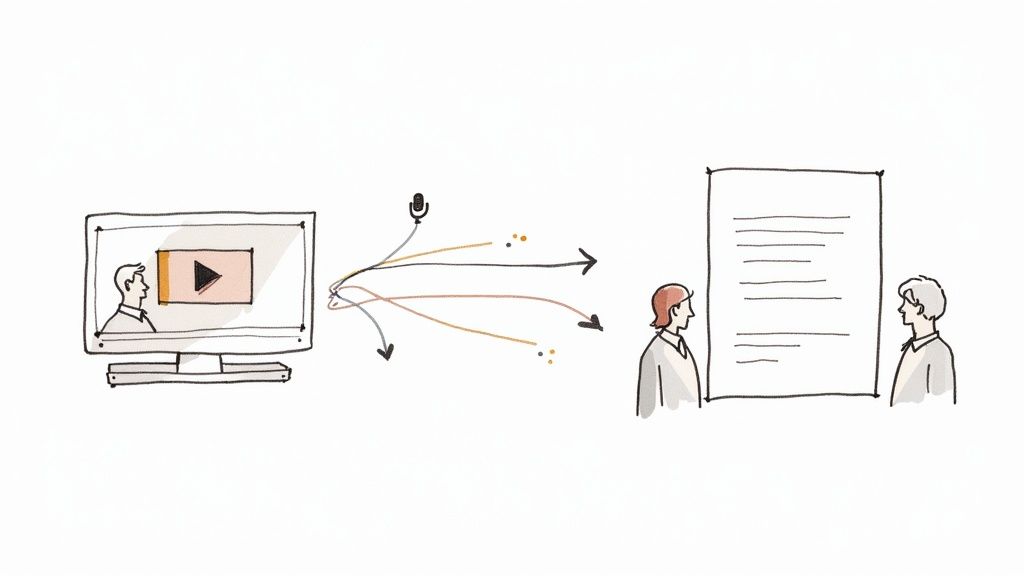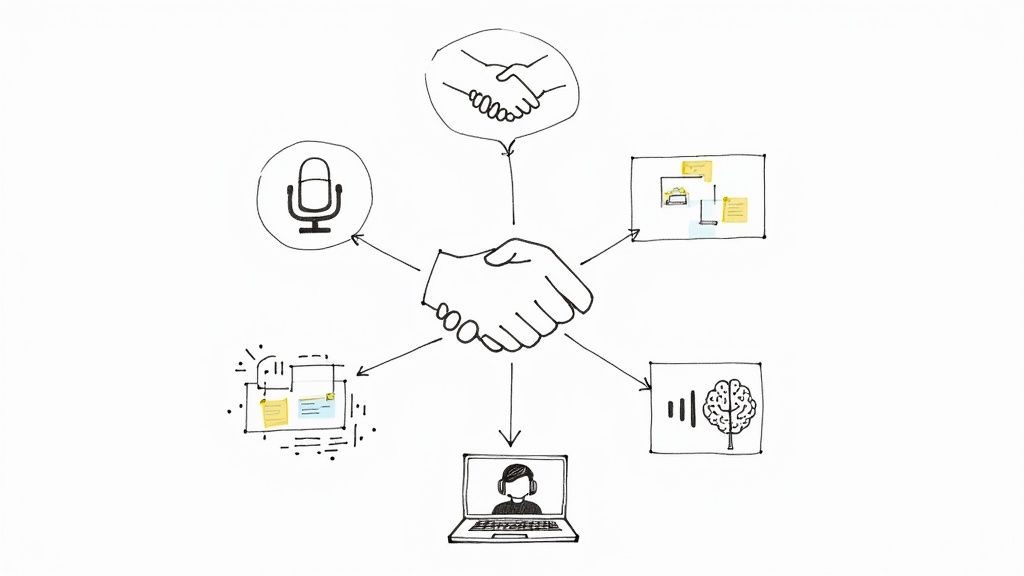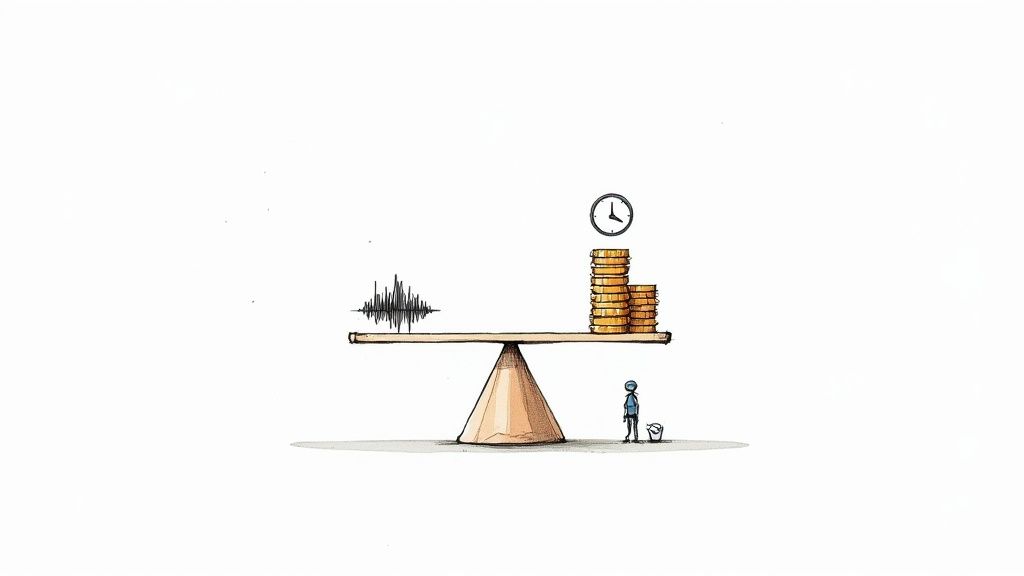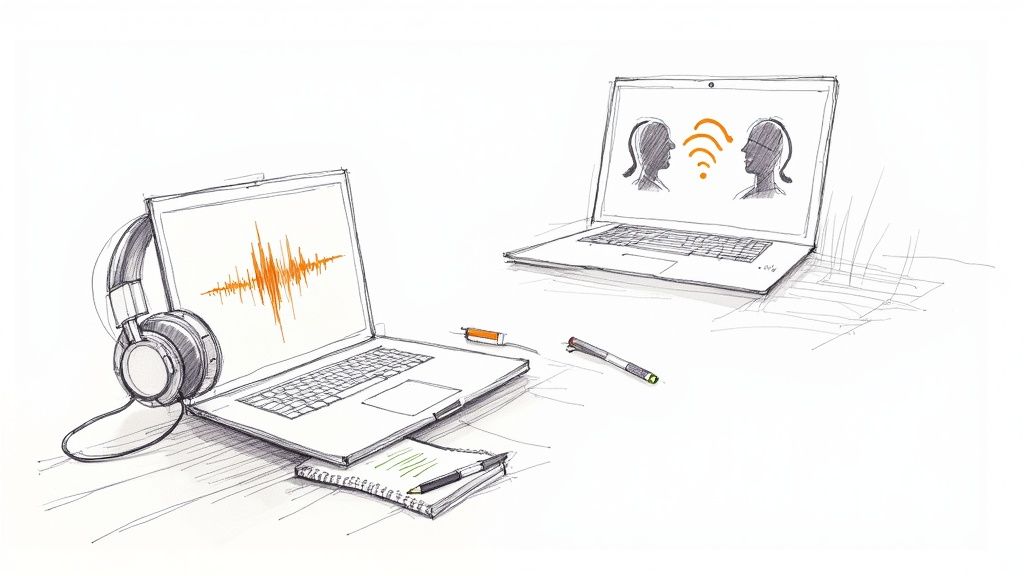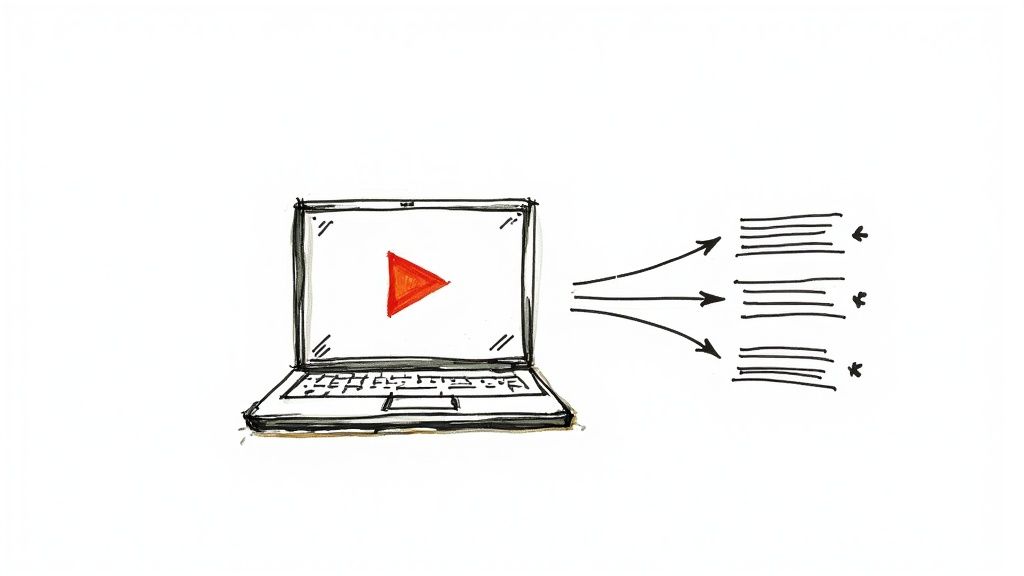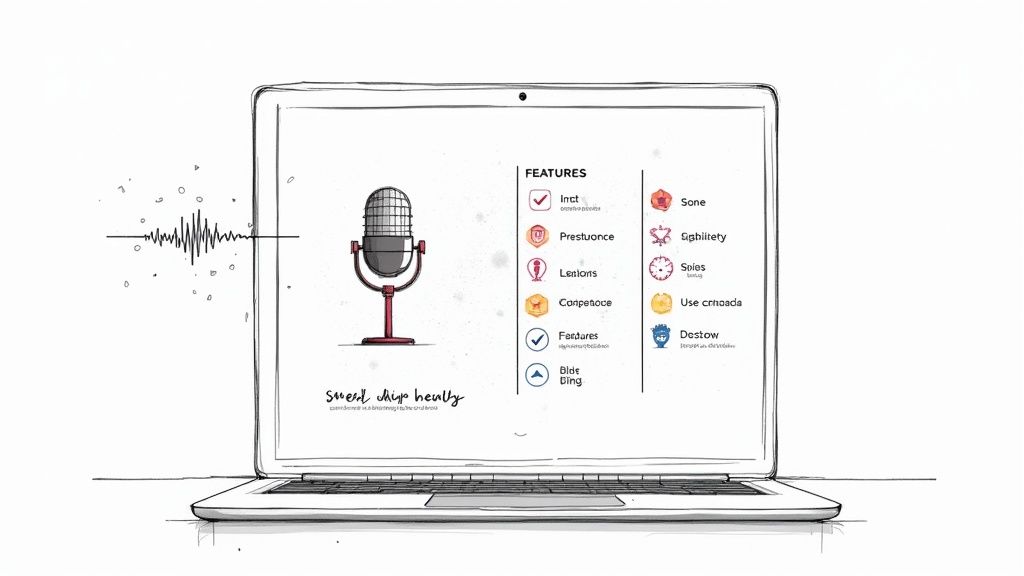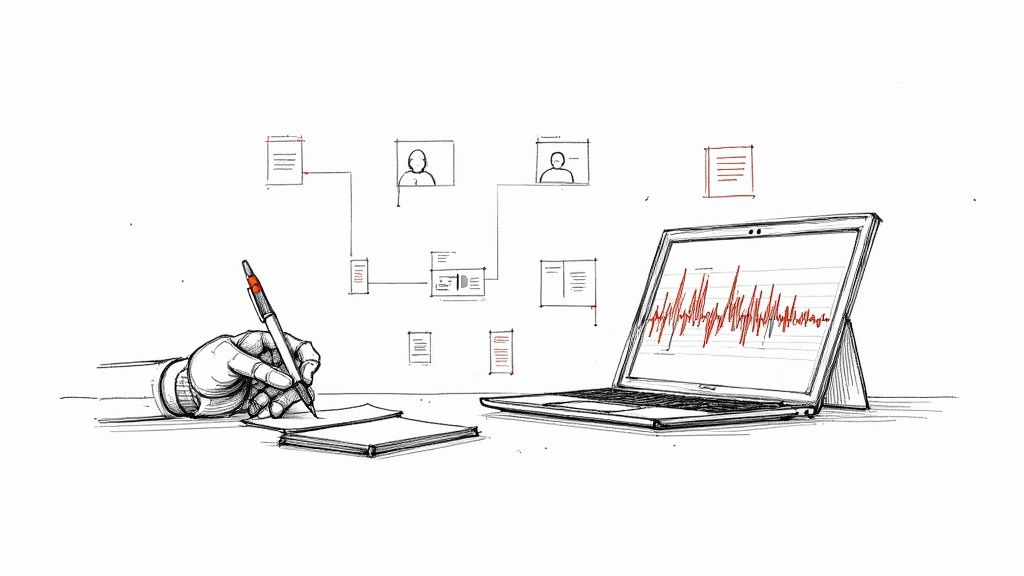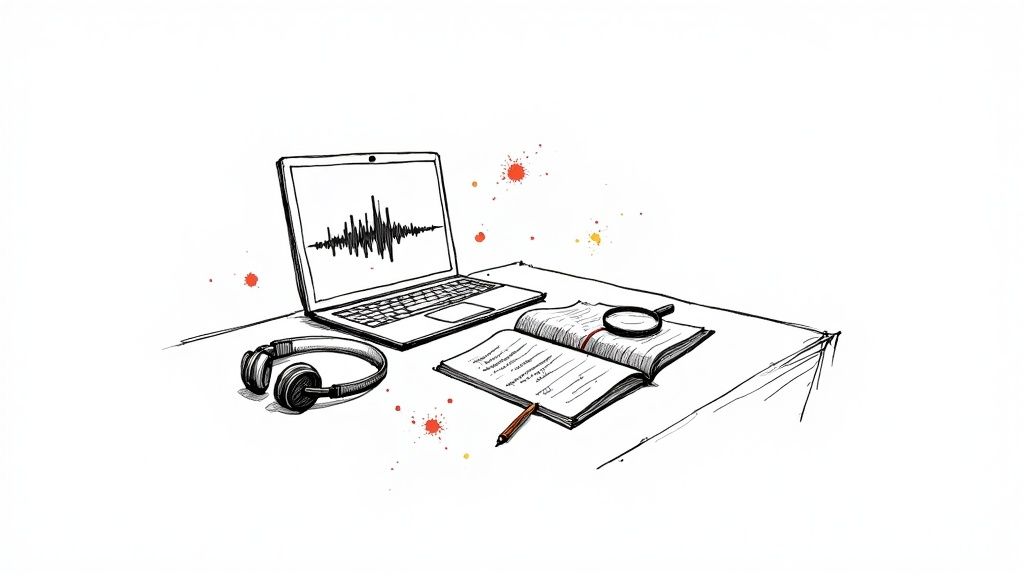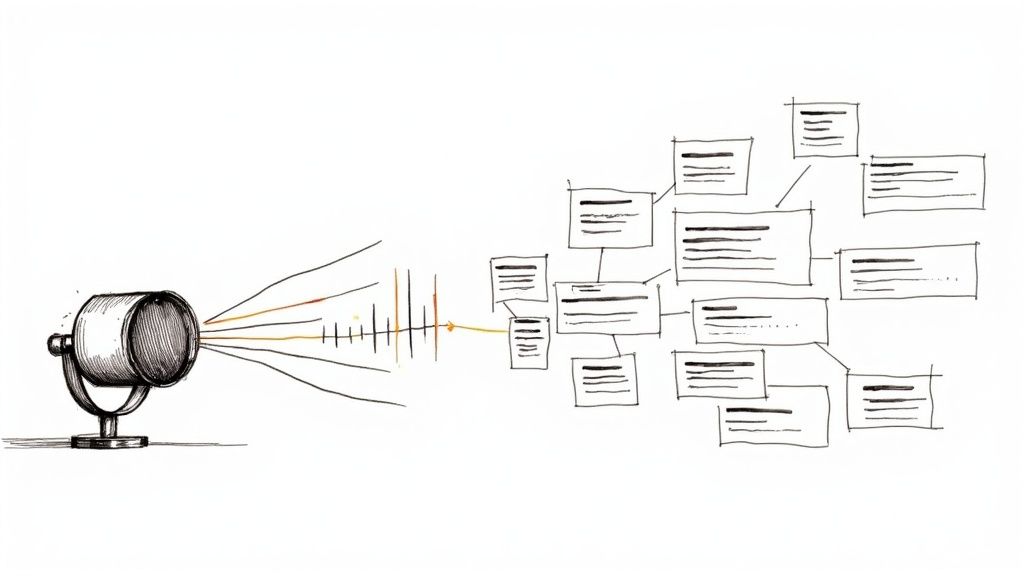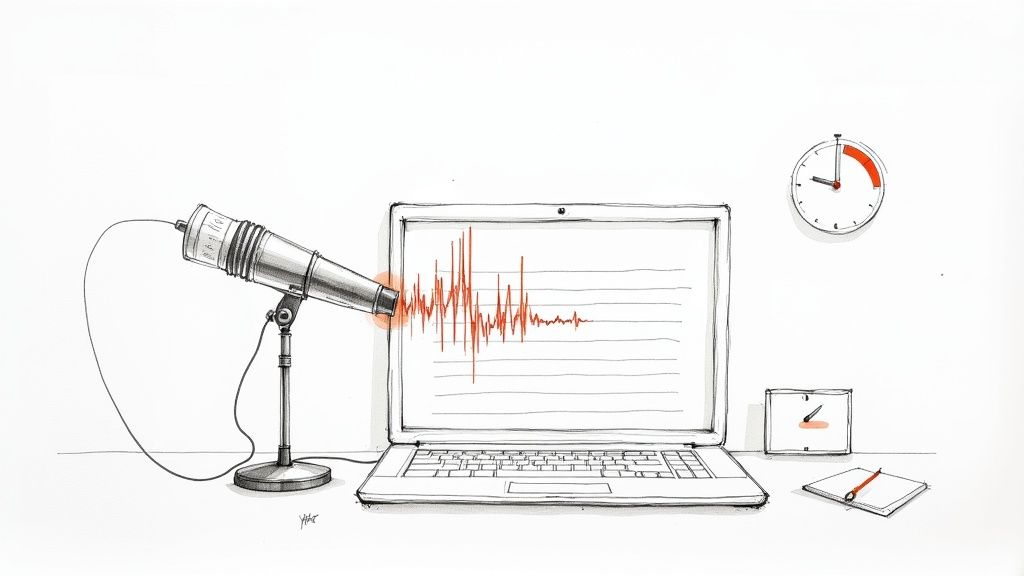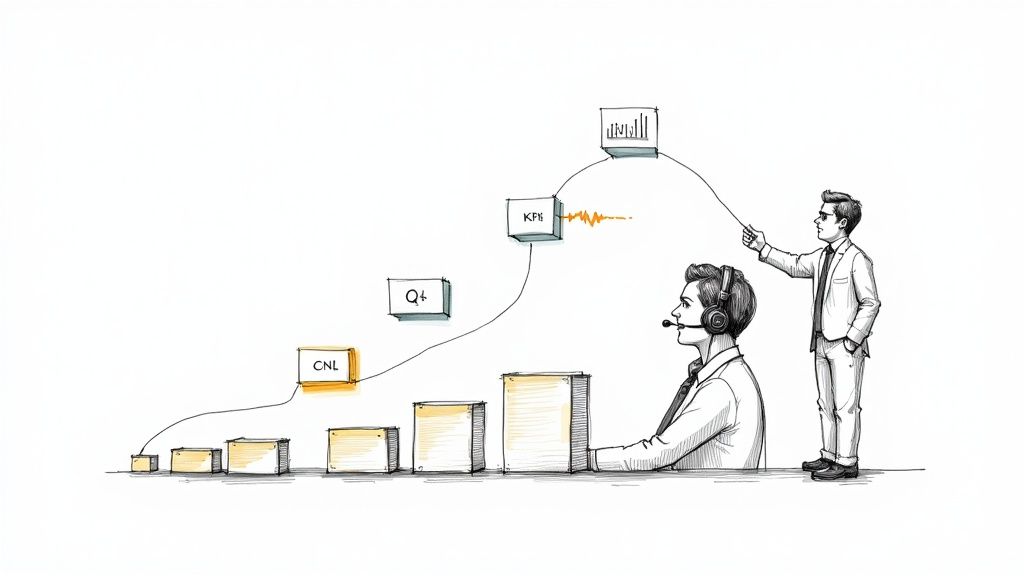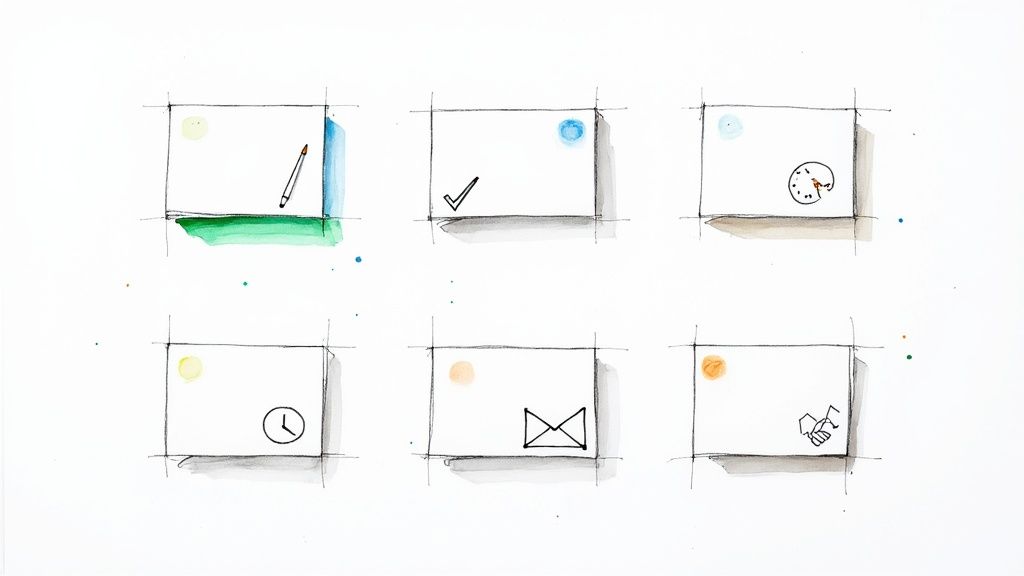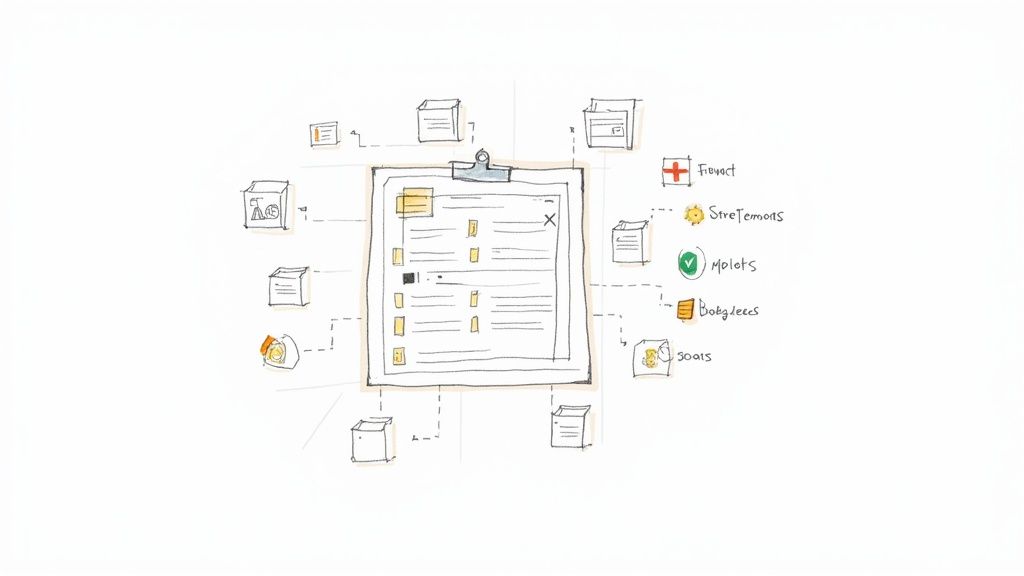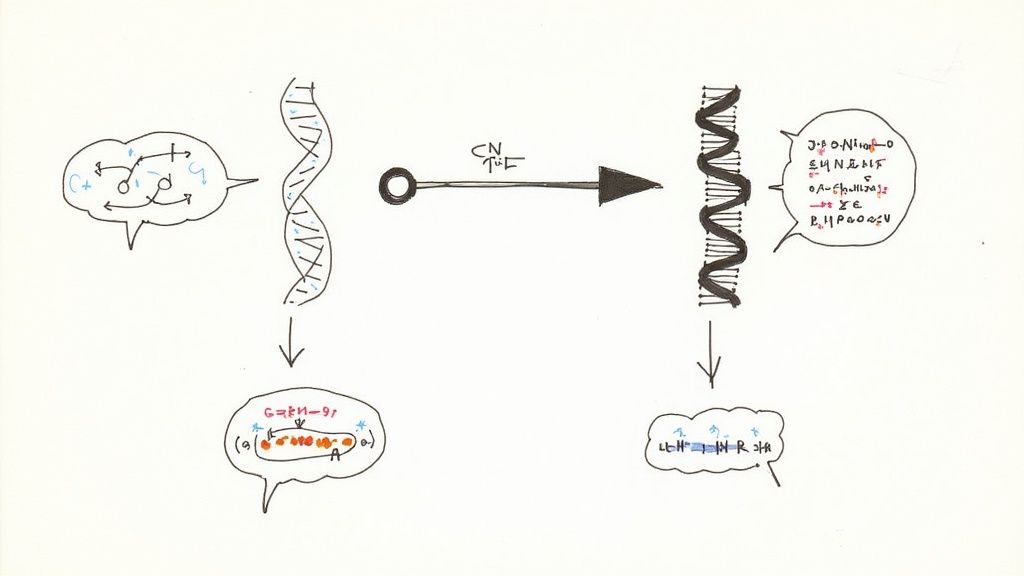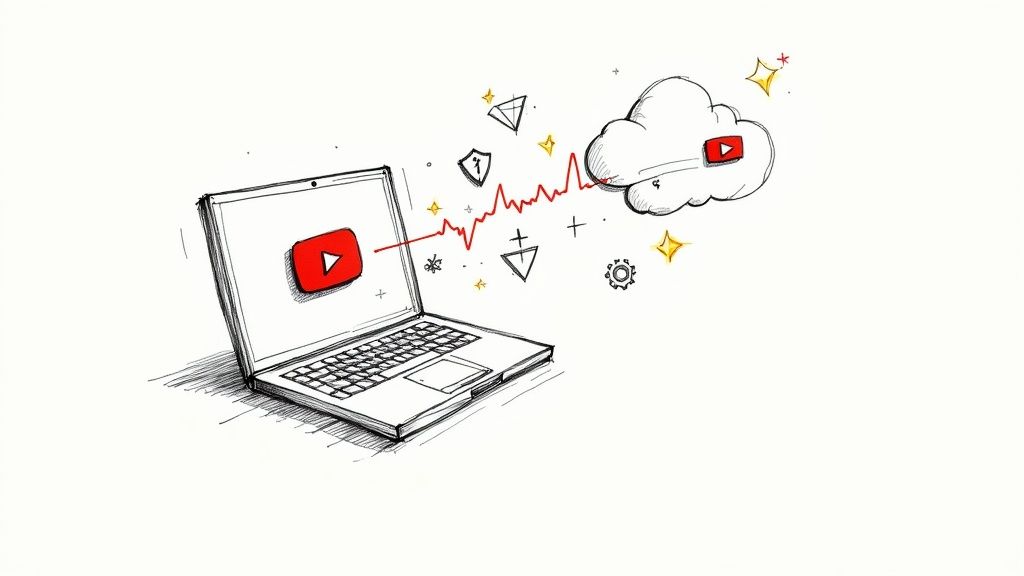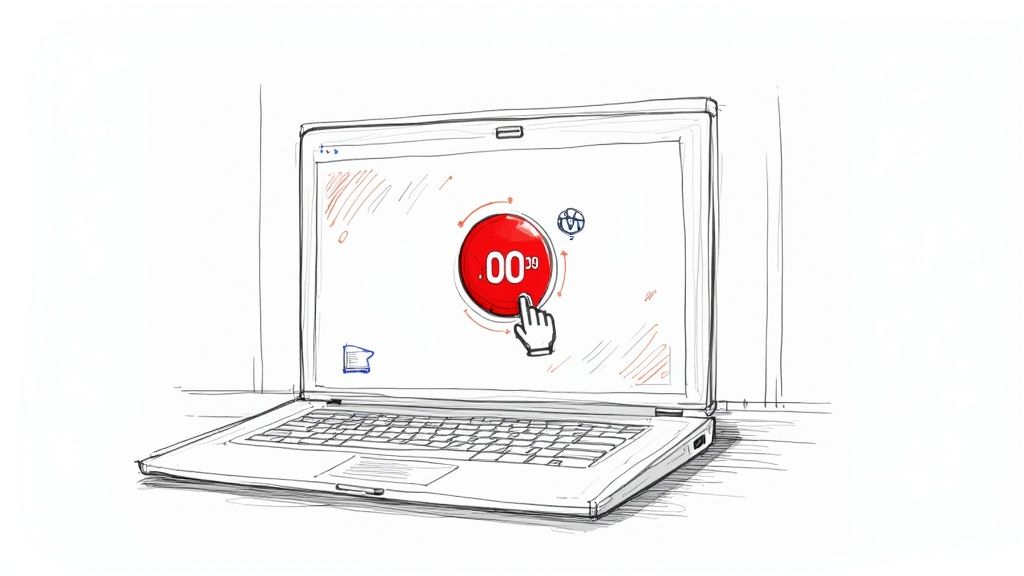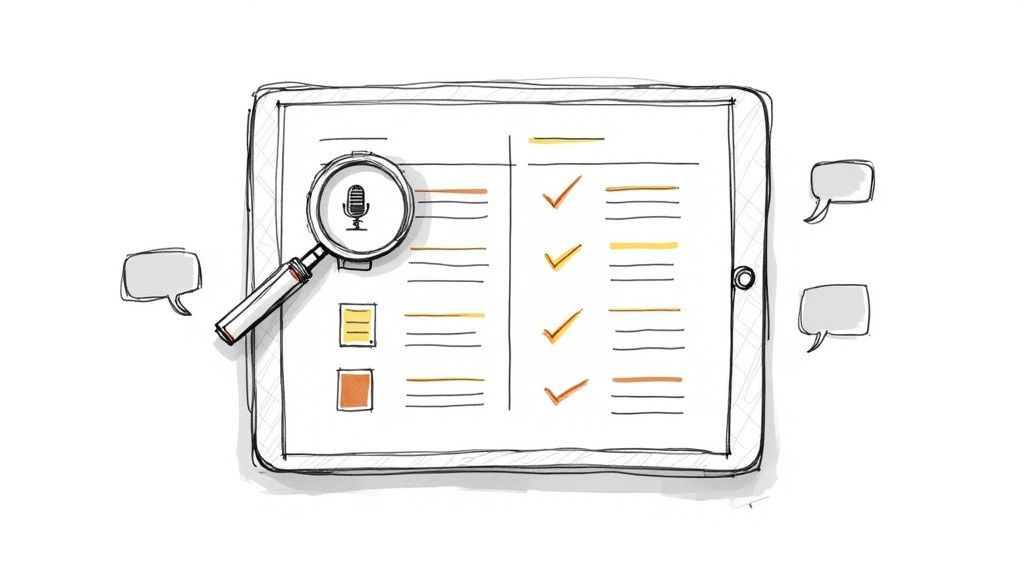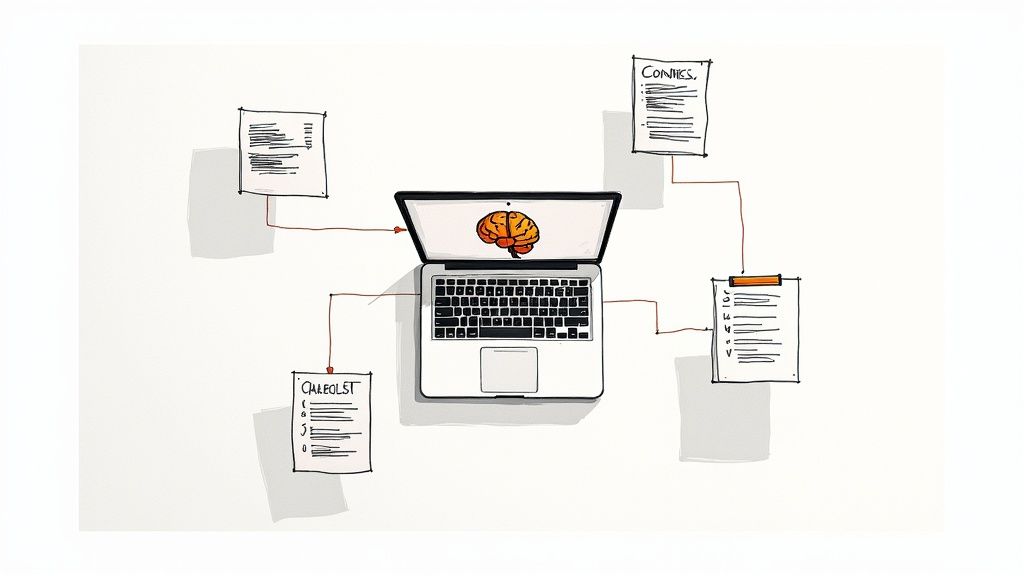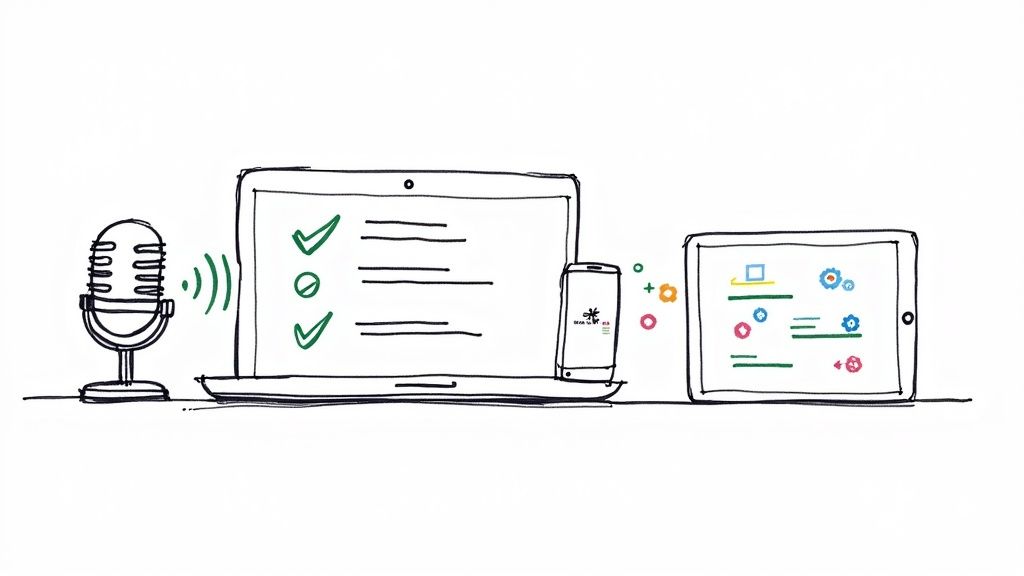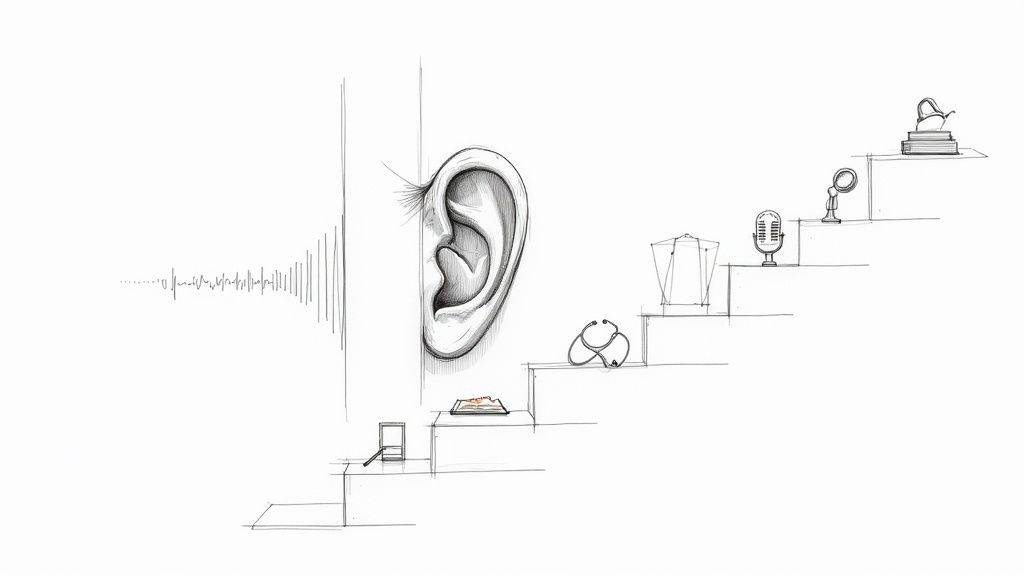Your Practical Guide to an Effective Meeting Minutes Format
Let's be honest—most meeting notes are a jumbled mess, quickly filed away and never looked at again. A solid meeting minutes format, however, gives you a simple, repeatable structure that turns a conversation into productive outcomes. This isn't just about taking notes; it's about creating an official record that keeps everyone aligned and makes key decisions crystal clear.
Why Does a Standard Meeting Minutes Format Matter?

Think about the last important meeting you were in. How much of that discussion can you honestly recall right now? From my experience, without a structured record, all those great insights and crucial action items simply evaporate. A standardized format prevents this by providing a reliable system for capturing what actually matters.
I’ve managed enough projects to see the night-and-day difference between a team that uses a consistent format and one that doesn't. The organized teams move faster because there’s no confusion about who is doing what or why a decision was made.
Creating a Foundation of Accountability and Clarity
A great format is essentially a blueprint for accountability. When you clearly assign action items with names and deadlines, there's no room for guessing games. This simple step turns a loose discussion into a concrete plan, which is a huge part of improving workplace communication.
This structured approach brings a few key advantages to any team:
- Creates a Single Source of Truth: The minutes become the official record, instantly settling any debates over what was actually decided.
- Drives Accountability: Clear action items ensure tasks don't get lost in the shuffle.
- Improves Focus: Knowing what needs to be documented helps keep the meeting itself on track and focused on results.
- Saves Time: Anyone who missed the meeting can get up to speed in minutes, no full debriefing needed.
The demand for this kind of documentation is growing. The global meeting minutes software market is projected to be worth millions of dollars by 2033, which shows how vital this process has become for businesses everywhere.
A well-crafted minutes document is more than just a record; it's a strategic tool. It ensures that the momentum generated during a meeting translates directly into progress afterward, preventing discussions from becoming dead ends. It’s the bridge between conversation and execution.
What Are the Core Components of Effective Meeting Minutes?
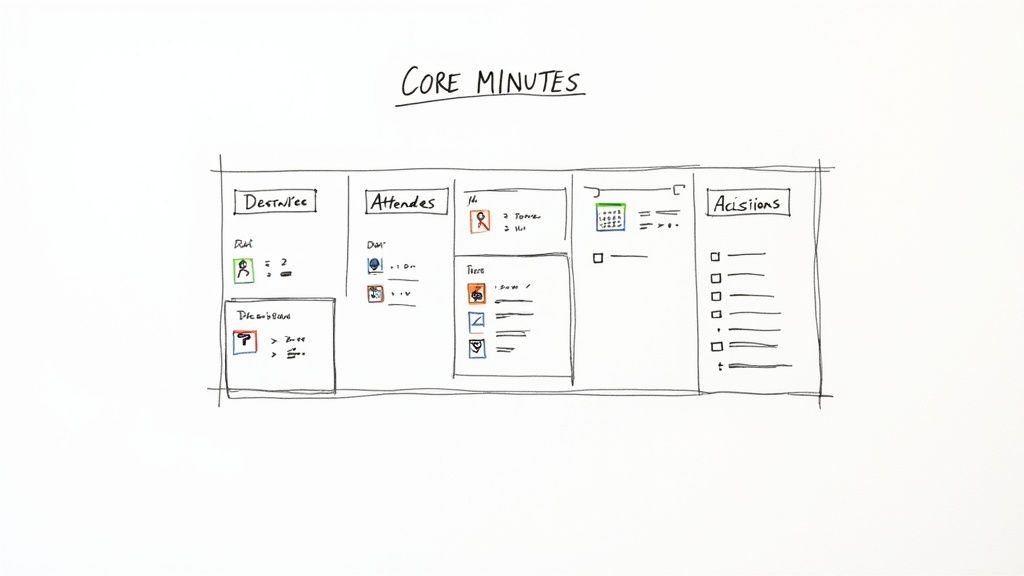
To create minutes that people actually use, you have to think beyond just jotting down notes. A truly solid set of meeting minutes is built on a foundation of clear, distinct sections, each serving a specific purpose. It’s the difference between a random collection of thoughts and a strategic document that drives action.
I've seen it time and again—teams get lost when the basics are missing. That's why every professional template starts with the fundamentals.
Foundational Meeting Details
First things first, you need the non-negotiable information that provides context at a glance. Without it, your minutes are just a floating document with no anchor.
- Meeting Title: Be specific. "Q4 Marketing Strategy Kickoff" is infinitely more helpful than "Marketing Meeting."
- Date and Time: This is essential for creating a chronological record of project decisions.
- Location: Was it in-person ("Conference Room B") or virtual ("Google Meet")? This small detail matters for context.
- List of Attendees and Absentees: This clarifies who was present for key decisions and who needs to be caught up. It’s a simple but powerful accountability tool.
These details might seem minor, but they form the bedrock of a professional record. They answer the who, what, when, and where before you even get to the why.
The Heart of the Minutes: Decisions and Actions
This is where your minutes shift from a simple record to a powerful tool for progress. The goal here isn't to capture every word spoken—it's to document outcomes with absolute clarity.
The real value of meeting minutes isn't in what was discussed; it's in what was decided. A great format focuses relentlessly on outcomes, ensuring every conversation leads to a clear decision or a specific, actionable next step.
So, instead of a vague note like "Discussed new software," you'd write, "Decision: Approved the purchase of HypeScribe Pro plan for the marketing team." The difference is night and day.
The same goes for action items. A lazy task like "John will look into the budget" is a recipe for inaction. A much better version is: "Action Item: John Doe to complete the Q4 budget variance analysis and share the report by EOD Friday, Oct. 25th." This defines the what, who, and when, leaving zero room for confusion.
This kind of precision is critical, especially given how teams operate today. While research shows that 45% of meetings are a brisk 30 minutes, a staggering 64% of them lack a structured agenda. Good minutes can fill that gap by creating the structure and accountability that was missing from the start. If you're curious, you can explore more data on meeting effectiveness and see just how vital documentation has become.
Let's break down these crucial parts into a quick reference table. Think of this as the essential anatomy for any set of professional meeting minutes.
Anatomy of Professional Meeting Minutes
This table outlines the essential components of any meeting minutes document, explaining what each part is for and offering a practical tip from my experience.
Having a clear structure like this isn't just about being organized; it's about turning conversations into tangible progress.
Download Your Free Meeting Minutes Template
Alright, you understand what goes into effective meeting minutes. Now, it's time to put it all into action without having to start from a blank page.
I've put together the exact meeting minutes format sample discussed in this guide, and it's ready for you to download. Think of it as your go-to framework for turning conversations into clear, actionable records. It's designed to be clean, simple, and easy for anyone on your team to follow.
The template is available in both Google Docs and Word formats, so you can easily tweak it to fit your company's style. Whether you're recording a formal board meeting or a casual team check-in, this structure will work.
Here’s a sneak peek at what you'll be getting.

As you can tell from the layout, the focus is on scannability. The essential details are right at the top, and the decisions and action items are impossible to miss.
Of course, taking great notes is only half the battle. Once the meeting is over, the real work begins. To make sure those action items actually get done, check out our guide on crafting the perfect meeting follow-up template.
A good template doesn't just record what was said; it drives what gets done. By standardizing how you capture decisions and next steps, you're building a system of accountability that turns meeting time into real progress.
How to Write Minutes That People Actually Use
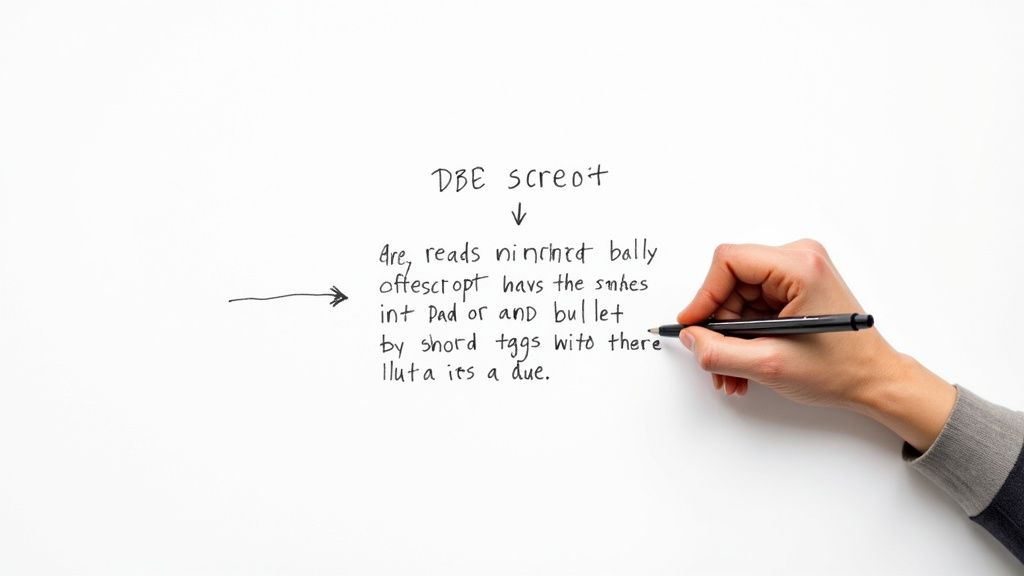
Having a great meeting minutes format sample is a solid starting point, but the real art is in how you bring it to life. Think of your role as less of a court stenographer and more of a strategic historian. Anyone can type what was said; your job is to crystallize what was decided and what happens next.
One of the biggest mistakes I see is people trying to write down every single word. This just creates a wall of text that's dense, hard to scan, and frankly, gets ignored. Your real goal is to capture the essence of the conversation and shine a spotlight on outcomes, not the winding road it took to get there.
It’s about using a clear, active voice to create a sense of forward momentum. For instance, instead of a passive "A new project timeline was discussed by the team," try something more definitive: "The team approved the revised project timeline." See the difference? One is a passive report; the other is a documented decision.
Focus on Outcomes, Not Conversations
To make your minutes genuinely useful, frame everything around results. For each item on the agenda, I always ask myself, "What was the final outcome here?" This one question is your best filter for cutting through the chatter and focusing on what truly matters.
This skill has become non-negotiable. The number of virtual meetings jumped from 48% to 77% between 2020 and 2022, a trend that's still shaping how we collaborate. With so many conversations happening remotely, clear and concise records are the glue holding projects together. You can dig into the data in the full report on the future of meetings.
Your notes need to clearly distinguish between three things:
- Key Discussion Points: A brief, one-sentence summary of the core ideas that shaped the outcome.
- Final Decisions: The verdict, stated clearly and unambiguously. I like to bold this part.
- Action Items: A specific task assigned to a specific person, complete with a deadline.
The most effective minute-takers are expert listeners. They listen for consensus, decisions, and commitments, and they filter out everything else. Their final document is a reflection of progress, not just conversation.
Staying Objective and Handling Disagreements
Staying neutral is crucial, especially when the conversation gets a little heated. Your role is to be an impartial recorder of the group's decisions, not to inject your own opinions or read into people's intentions. When you're documenting a sensitive topic, stick to the facts—and only the facts.
If a decision comes after a lively debate, you don't need to capture the play-by-play of the argument. Just record the result. For example: "After reviewing arguments for and against, the committee voted to proceed with Option B." It’s professional, fair, and keeps the focus where it belongs: on the official record. Nailing these details is how you turn your meeting notes into concrete action items.
Common Minute-Taking Mistakes to Avoid
Even with the best meeting minutes template in hand, it’s surprisingly easy to make a few common mistakes that can render your notes useless. We’ve all seen them: the minutes that are so vague they’re meaningless, or the ones that are so long nobody actually reads them.
The key is learning what not to do. From my experience, avoiding these classic blunders is what elevates your minutes from a procedural chore to a genuinely useful tool for your team.
One of the biggest traps I see people fall into is letting their own opinions or interpretations sneak into the summary. Your role as the minute-taker is to be a neutral observer—a scribe, not a commentator. Stick to the facts of what was discussed and decided, not what you think about those decisions.
Another pitfall is writing down action items that are fuzzy or unclear. A task assigned to a general "team" with no specific owner or deadline is practically designed to be forgotten.
Turning Vague Tasks into Actionable Steps
When it comes to accountability, clarity is your best friend. Every single action item needs to spell out three things: Who is responsible, what exactly they need to do, and when it's due.
Let's look at a real-world example of how to sharpen a weak action item:
- Vague: "Marketing to work on the new campaign."
- Actionable: "John Smith to draft the Q1 campaign brief and share it with the team for feedback by EOD Friday, March 5th."
See the difference? There’s no room for confusion there. Everyone knows who owns the task and when to expect it, which makes follow-up a breeze.
The single biggest mistake is waiting too long to distribute the minutes. The value of the information decays rapidly. Sending them out within 24 hours ensures the details are still fresh in everyone's minds and that momentum from the meeting isn’t lost.
Finally, resist the urge to transcribe the entire meeting. Your job isn't to create a word-for-word script of every "um" and "ah." The goal is to produce a concise, scannable summary. Focus on capturing the core decisions, key takeaways, and next steps—and leave all the conversational filler on the cutting room floor.
Your Questions About Meeting Minutes, Answered
You have the format down, but taking minutes in the real world always brings up a few tricky questions. Here are some of the most common ones I've heard over the years, answered with practical advice.
What’s the Real Difference Between Notes and Minutes?
I like to think of it this way: meeting notes are for your personal reference, but meeting minutes are the official record for the entire team.
Your personal notes are your own cheat sheet. They can be messy, filled with shorthand, or even include your own candid thoughts and questions. They’re a tool to help you follow the conversation.
Meeting minutes, on the other hand, must be clean, objective, and structured so that anyone—even someone who wasn't there—can understand what was decided. They serve as the single source of truth for the entire team.
How Quickly Should I Send Out Meeting Minutes?
My rule of thumb is to send them out within 24 hours. This isn't just an arbitrary deadline; the value of meeting minutes drops off a cliff the longer you wait.
When you send them out quickly, the discussion is still fresh in everyone's mind. People are more likely to catch an error or remember a small detail you might have missed. More importantly, it keeps the momentum going and shows that the action items assigned are meant to be started now, not next week.
Pro Tip: Don't let minutes become an afterthought. When you delay sending them, you're unintentionally signaling that the follow-up isn't a priority. Sending them promptly turns a simple document into a powerful accountability tool.
Who Needs to Approve the Minutes?
The approval process can change depending on the meeting's formality, but it usually follows a simple path. After the note-taker drafts the minutes, the meeting chair or host should be the first to review them for accuracy.
- For formal board or committee meetings: The minutes are often tabled for official approval at the start of the very next meeting.
- For typical team meetings: A more casual approach works fine. A simple line in your email like, "Let me know if you see any corrections by the end of the day," is usually all you need.
Should I Record the Meeting to Help with Minutes?
Recording a meeting can be a great backup, but you need to be smart about it. Having an audio or video file is fantastic for double-checking a specific quote or clarifying a complex decision, especially if you're trying to take notes and participate at the same time.
However, you should always get explicit consent from everyone before you hit record. Privacy is key. Also, don't fall into the trap of just transcribing the entire recording. Nobody wants to read a 20-page script. The recording is just a tool to help you create a concise and accurate summary.
Tired of manually typing up every detail? HypeScribe uses AI to automatically transcribe and summarize your meetings, delivering accurate notes, key takeaways, and action items in seconds. Stop documenting and start deciding by visiting https://www.hypescribe.com to see how it works.



